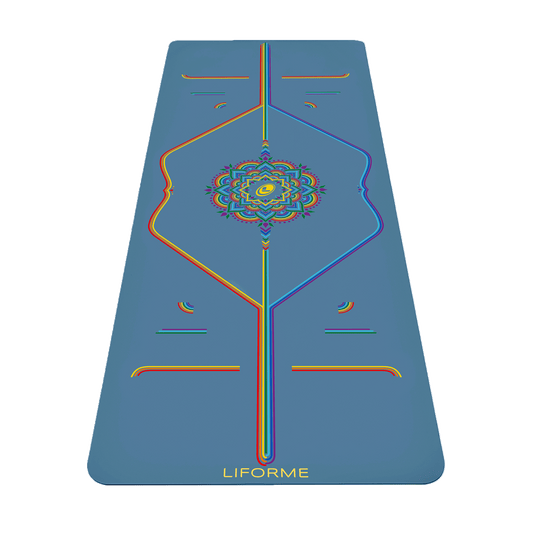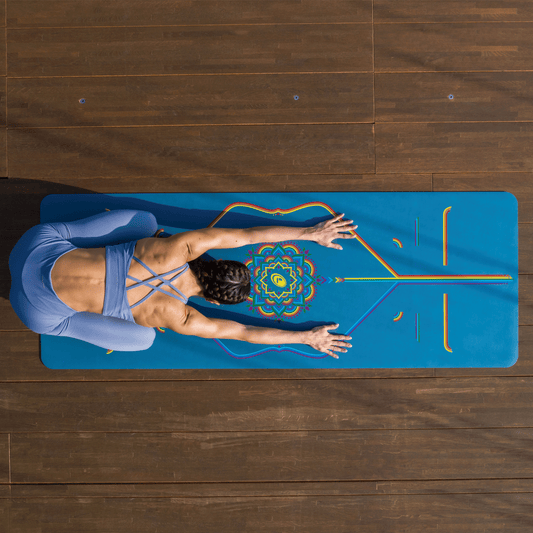What Is Yoga Alignment?
Alignment is the term we use in yoga to describe the precise way to do any given pose in order to maximize its benefits and minimize the risk of injury. The ideal, if you will. Now, when you hear words like ‘precise’ and ‘ideal’, we understand if you start to get freaked out. You might feel like you are being judged by the concept of alignment. After all, aren’t you also being told to listen to your body and to prioritize what it tells you over what any teacher might say?
We get that, but alignment isn’t here to try to put everyone into a little box, weed out the people whose bodies don’t fit the ‘ideal’, or scold people who make adjustments to make things work for them. Quite the opposite, actually.
Alignment is a flexible structure that offers options for practitioners of all levels, shapes and sizes, no matter what. It encourages the use of props, modifications, and good old common sense in the service of finding the safest and most beneficial way for each body to fully experience each pose. When you understand alignment, you have the tools to make almost any yoga pose work for you.
You may be surprised to hear that there isn’t one enshrined canon of alignment rules that’s been passed down through the ages. As yoga has evolved, different traditions have interpreted their own alignment systems, some of which contradict each other. This can cause confusion, but it also opens the door for an individualized approach, taking what works for you from different methods.
Why Is Alignment So Important?
Alignment is intended to create a stable foundation for a safe practice, to allow your body to open in new ways, and to reduce your risk of injury. While you might not feel a sudden, sharp pain from doing a pose out of alignment, many yoga injuries are cumulative, accruing little by little. Wear and tear on joints and supporting tissues happens over time, so many yoga students find themselves with repetitive use ailments years into their practices and have to break long-established patterns to remake their poses in healthier ways. That’s why it’s important to establish optimal alignment (for your own body) as early in your practice as possible, which often means using props liberally.
Using props, like a grippy, supportive mat, yoga blocks, and straps, is not in any way a sign of inadequacy. These props are intended to help yoga students practice with good alignment right from their very first day instead of compromising their form. For instance, in a Standing Forward Fold (Uttanasana), you might not be able to touch the ground with your hands while keeping a straight spine. You could let the spine round or bend your knees, but then you are missing out on stretching the hamstrings and opening the chest. Using blocks under your hands allows you to hit every note of the pose in the safest way.

A yoga mat with good traction is an undervalued asset when it comes to alignment. Take a pose like Downward Facing Dog (Adho Mukha Svanasana). If your hands and/or feet are slipping out from under you in this position because your mat can’t handle a bit of sweat, you’re either going to end up sliding out to a longer Dog or overcompensating for slippage by shortening the distance between your hands and feet. In either of these cases, the benefits of the pose are undermined and a pattern that places undue stress on the shoulders, hips, and spine is established.

Techniques to Improve Your Alignment
Try this little experiment. With your eyes closed, step from Downward Facing Dog to Mountain Pose (Tadasana) at the front of your mat. Do your best to land with your feet at hips’ distance apart and parallel. Without touching them, try to judge whether your toes are lined up. After taking several breaths, start to stack your hips over your ankles and then your shoulders over your hips. When you think everything is as it should be, open your eyes and check where your feet are. Chances are, they are not as perfectly placed as you thought, meaning that your careful stacking is going to be a little bit skewed too. Even very experienced yogis rely on their senses of sight and touch to help them place their bodies.
At first, alignment is not necessarily intuitive. It takes some experience to be able to cultivate an awareness of where your body is in space throughout a practice session. The first alignment input you get will probably be a spoken cue from your teacher or maybe a visual demonstration. They might say, ‘square your hips toward the front of the room’. At first, you might not understand what that means or how to implement it in your own body. The teacher may then offer a manual adjustment by touching you to steer your body in the right direction. However, manual adjustments are becoming less common, especially in large classes where the teacher can’t get to everyone’s mat. And even if you are physically adjusted, it’s hard to remember what to do the next time you’re in each particular pose.

The Benefits of an Alignment Yoga Mat
This is where Liforme’s unique AlignForMe system comes in, putting another tool at your disposal. It’s difficult to write a line of text straight across a blank page, so we use lined paper to give us a guide. You can choose to write all over the page if you want, but the lines are there if you want them. Using our AlignForMe guide on the mat is a bit like writing on lined paper. It makes sense, is simple and intuitive, and doesn’t hinder your natural flow..
The most basic marking, which anchors all of Liforme’s mats, is the Central Line. In standing poses, you need to know where your body’s midline is. Together with the End to End Lines at the front and back of your mat, you now have a basic framework upon which to hang your alignment.
When your feet are at the front of your mat, make sure that that they are equidistant (width-ways) from the Central Line and lined up (length-ways) with the End to End markers. You don’t have to be finicky about it, placing your feet exactly on the lines. It’s easy to just glance down and quickly make the adjustments that will bring your body into better balance. You don’t want to build your pose on a shaky foundation.
If you use a Liforme mat in class, you’re more likely to remember how to set up your poses the next time you practice them. The AlignFor Me graphic helps you begin to see patterns, so you’ll understand which poses are variations on a theme, making new poses feel more accessible. Over time, you’ll find that glancing at the lines on your mat as you flow from pose to pose has become second nature. As your practice evolves and your body changes, you’ll probably use the lines in different ways. They will always be there, symmetrical and true.

Alignment Is Power
Focusing on alignment fosters your growing sense of body awareness and boosts your self-confidence. A lot of people feel quite disconnected from their physical bodies. Yoga works to reintegrate the body and mind with alignment as one of its primary tools. Poses that feel unfamiliar and shaky at first soon become intuitive and steady with the help of good instruction and the right tools.





































